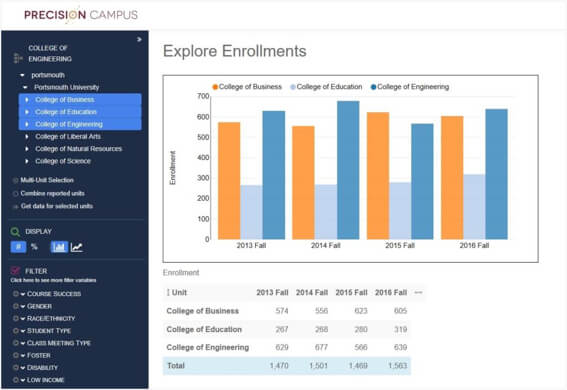
Tracking College Enrollment Trends
What is the Current State of Enrollment in Higher Education?
The higher education landscape is changing — most noticeably when looking at enrollment patterns for colleges and universities all across the country.
Your data analytics platform will show that enrollments typically fluctuate on a day-to-day basis. However, declines have persisted for some time now, causing institutional leadership to second-guess strategies.
The Data Behind Enrollment Trends
There are many internal and external factors that can lead to enrollment variabilities, whether on a semester-by-semester or year-over-year basis. We’ve found the following current events to be the biggest contributors:

The High Cost of Tuition
Comparing present day to 30 years ago, TheBestSchools.org reports the following:
- 146% tuition increase for private 4-year schools
- 225% tuition increase for public 4-year schools
- $1.4 trillion of student loan debt

A Drop in the U.S. Birthrate
Scholars from the University of New Hampshire estimate that between 2008 and 2013, 2.3 million fewer babies were born.
When you compare this drop to the expansions being made at many institutions, there will inevitably be too many open slots and not enough applicants.

The Economy
A healthy economy has traditionally meant low college admission rates. In contrast, college admissions across the country spiked during the 2007-2008 recession when unemployment rates were high and economic uncertainty was prevalent.
When the recession was over in 2011, the National Student Clearinghouse Research Center found that college enrollments dropped by close to 1 million students — and it’s been on a consistent decline ever since.
These external factors are causes for concern, but not impossible challenges.
Post-secondary and ongoing education will always be valuable, even as the industry evolves and trends fluctuate. The key to surviving lies in using what your institution already has an abundance of — data — to your benefit.
How Data Analytics Software Supports Your Institution’s Efforts
There’s no reason to hope for a recession. Staying ahead of the volatility in the industry requires making data-driven decisions, which can only be achieved by gaining a complete view of your institutional data.
Precision Campus was built purposefully for higher education, by a founder who has spent his entire career working in institutional research. Our data analytics platform takes standard institutional data sets — like enrollment numbers — and transforms them into interactive, pattern-revealing tools.
Cloud-based, automated and fully hosted, Precision Campus includes the standard required reports, with the ability to customize them to your exact needs and goals
- Use our year-over-year enrollment report for a daily, real-time view of enrollments.
- Analyze a full-time student equivalent report as a budgeting tool.
- Check your census productivity report for a look at your financial stability.
- Assess classroom utilization data to better allocate resources.
